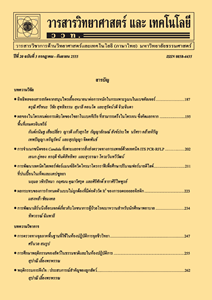การสร้างภาพสามมิติของการเจริญบริเวณอุ้งเชิงกรานในตัวอ่อนไก่อายุ 9 วัน
Main Article Content
Abstract
Development of organs in organisms has been studied for long time. They have been studied by both serial sections and whole-mount under microscopic investigation to demonstrate the developmental processes in either micrographs or drawings. Although the developmental processes are well defined, they remain ignoring the dimension. Nowadays, the technology called 3D reconstruction increases the capability of embryological studies including the third dimension (z-axis or thickness) and volumetric data to visualize the developmental mechanism in natural environment. This research aims to apply the 3D reconstruction and morphometry to illustrate the normal development of pelvic region in 9-day chick embryo. The serial sections were imported and analyzed histologically and volumetrically in Amira 3D software. The 3D model was further remodelled in Cinema 4D program to decrease sectioning noise which disrupt the perspective. The 3D model from the reconstruction showed that it can rotate to visualize the topography of the pelvic structures and compare the volume of organs in pelvic region. The main results found that a created 3D image reconstruction can visualize the pelvic region structure close to the real embryo structure. Moreover, the differentiation of the pelvic region structure at the tissue level can be illustrated by a created 3D image reconstruction. Thus, this created 3D image reconstruction is able be used as a tool for demonstrating the morphological changes in embryonic development.
Article Details
References
[2] de Bakker, B.S., de Jong, K.H., Hagoort, J., de Bree, K., Besselink, C.T., de Kanter, F.E.C., Veldhuis, T., Bais, B., Schildmeijer, R., Ruijter, J.M., Oostra, R.J., Christoffels, V.M. and Moorman, A.F., 2016, An interactive three-dimensional digital atlas and quantitative database of human development, Science 354: aag0053.
[3] Arey, L.B., 1974, Developmental Anatomy: A Textbook and Laboratory Manual of Embryology, 7th ED., Saunders, Inc., Philadelphia, 695 p.
[4] Boonnoon, N., Chotyakul, N. and Kruepunga, N., 2016, Effects of soybean phytoestrogens on the development of avian reproductive system, Panyapiwat J. 8: 272-283.
[5] Kruepunga, N., Hikspoors, J.P., Mekonen, H.K., Mommen, G.M., Meemon, K., Weerachatyanukul, W., Asuvapongpatana, S., Köhler, SE. and Lamer, W.H., 2018, The development of the cloaca in the human embryo, J. Anat. 234: 724-739.
[6] Bellairs, R. and Osmond, M., 2014, The Atlas of Chick Development, 3rd Ed., Academic Press, Oxford, 692 p.
[7] Mekonen, H.K., Hikspoors, J.P., Mommen, G., Kruepunga, N., Köhler, S.E. and Lamers, W.H., 2017, Closure of the vertebral canal in human embryos and fetuses, J. Anat. 231: 260-274.
[8] Intarapat, S. and Stern, C.D., 2014, Left-right asymmetry in chicken embryonic gonads, J. Poult. Sci. 51: 352-358.
[9] Belle, M., Godefroy, D., Couly, G., Malone, S.A., Collier, F., Giacobini, P. and Chédotal, A., 2017, Tridimensional visualization and analysis of early human development, Cell 169: 161-173.
[10] Lukeneder A., 2012, Computed 3D visualisation of an extinct cephalopod using computer tomographs, Comput. Geosci. 45: 68-74.
[11] Zilverschoon, M., Vincken, K.L. and Bleys, R.L., 2017, The virtual dissecting room: Creating highly detailed anatomy models for educational purposes, J. Biomed. Inform. 65: 58-75.
[12] Javan, R., Herrin, D. and Tangestanipoor, A., 2016, Understanding spatially complex segmental and branch anatomy using 3D printing: Liver, lung, prostate, coronary arteries, and circle of willis, Acad. Radiol. 23: 1183-1189.
[13] Paul, G.M., Rezaienia, A., Wen, P., Condoor, S., Parkar, N., King, W. and Korakianitis, T., 2018, Medical applications for 3D printing: Recent developments, Missouri Med. 115: 75-81.
[14] AlAli, A.B., Griffin, M.F. and Butler, P.E., 2015, Medical applications for 3D printing: Recent developments, Missouri Med. 115: 75-81.
[15] Marro, A., Bandukwala, T. and Mak, W., 2016, Three-dimensional printing and medical imaging: A review of the methods and applications, Curr. Probl. Diagn. Radiol. 45: 2-9.
[16] Cromeens, B.P., Ray, W.C., Hoehne, B., Abayneh, F., Adler, B. and Besner, G.E., 2017, Facilitating surgeon understanding of complex anatomy using a three-dimensional printed model, J. Surg. Res. 216: 18-25.


